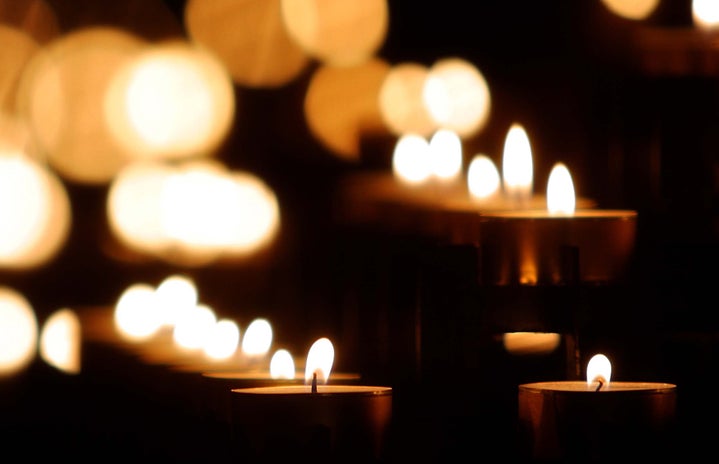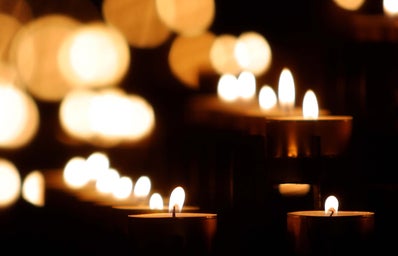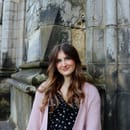Holocaust Memorial Day is an annual day of remembrance held on January 27th for all those who lost their lives or were impacted by the events of the Holocaust, which shook throughout Europe in the 1940s.
The Holocaust aimed to eradicate Jewish people due to the antisemitic feelings of the perpetrators; however, other groups of people were also targeted due to the colour of their skin, their nationality, their political stance, their religious beliefs, their disability, or who they loved. Therefore, this was a dark period where many people lost their lives for simply being who they were, and those who did not lose their lives were impacted by hate and discrimination as well as loss of culture, traditions, community, and language.
It is integral that, as a society, we learn from this cruel period in history and do our utmost to remember the lives of the people it took. This year, the University of St Andrews held a Holocaust Memorial Day Vigil in St Salvators Quad to honour those whose lives were taken from them too soon due to hate and prejudice. In addition, an exhibition was open to all students in the Student’s Association, presented by the Union of Jewish Students (UJS), which followed a timeline of the history of the Holocaust, educating the people of St Andrews on one of history’s most shocking genocides.
Outwith our little St Andrews Community, The Holocaust Educational Trust brought students and individuals from all over the UK together on January 23rd to hear a webcast of a Holocaust survivor sharing the story of their experiences. Viewers were allowed to interact and ask questions, making it an educational tool for all generations post-Holocaust. As well as this, the Holocaust Memorial Trust held their annual ‘Light the Darkness’ moment, which united the nation as lit candles were placed in windows across the country to “remember those who were murdered for who they were and to stand against prejudice and hatred today”. Landmarks across the nation, such as the Millennium Wheel in London, were illuminated in purple to mark the Memorial Day.
Every victim of the Holocaust deserves to have their story known and kept alive through the generations; however, that would be an impossible task for this article due to the magnitude of the victims. Therefore, this article explores the heroic tales of just three women involved in and impacted by the Holocaust. I find it to be of utmost importance not only to celebrate the triumphs, endurance, and leadership of womanhood in today’s times but also those of the past. Without their examples of strength in times of adversity, we would not have the strong, independent female leaders of today. This is why it is crucial that their stories are not lost to time.
Sofka Skipwith
Sofka Skipwith was a Russian princess, born in 1907 in St. Petersburg, Russia. She was a direct descendant of Catherine the Great. In May 1940, Sofka travelled to Paris to assist her frail mother, but 10 days later, Germans marched into Paris, where she was arrested and sent to an internment camp in Vittel, France. According to her fellow inmates, Sofka endeavoured to improve morale in the camp by organising cultural activities and advocating for prisoners’ rights. She maintained contact with French Resistance Leaders and communicated with them in secret to alert them of what was happening within the camp.
In 1943, 250 Polish Jewish people made their way to Vittel. They all had documentation proving their South American status, which should have protected them from being admitted to camps; however, the Germans deemed these papers fake and arrested them regardless. Sofka was troubled by the Polish-Jewish stories of antisemitic treatment and persecution and later stated, “The thing that struck us most about these newcomers was their air of sleepwalkers. They appeared dazed. They spoke little, never seemed to smile, walked slowly in the park, as though nervous of doing wrong.”
Sofka discovered that the large group of Polish-Jewish people were being held at Vittel for a short period before being transferred to Auschwitz. She saw it as her duty to save these people from perishing. She wrote all 250 names of these people in tiny font on cigarette paper and sent them to her resistance contacts in hopes they would certify that these Jewish people were South American citizens. She also made sure a Jewish baby got to safety by smuggling them under a fence. However, to Sofka’s dismay, she never received a response from her resistance contacts and spent many years believing that these people had perished.
However, in 1985, 42 years after her last encounter with the group of Jewish people she met in the camp, she discovered that 50 of the names she sent to the resistance were taken off the train to Auschwitz, meaning they didn’t die in Auschwitz. Therefore, while a prisoner herself, Sofka managed to heroically save the lives of 51 people.
Finally, in August 1944, Sofka left her camp and returned to England, although she could have returned sooner had she not decided to stay to support her fellow inmates. Sofka spent the rest of her life as a human rights activist and a Holocaust educator before her death in 1994. In honour of her actions in times of adversity, Sofka Skipwith was posthumously honoured as Righteous Among the Nations by the Israeli Holocaust Memorial Yad Vashem. Following this, in 2010, Sofka was one of 25 people to be posthumously honoured by the UK as a British Hero of the Holocaust.
Eva Mozes Kor
A tale of resilience and sisterhood, Eva Mozes Kor was born in 1934 in Portz, Romania, alongside her twin sister Miriam. They were the only Jewish family in their little village. When the girls were five years old, their village was taken back by Hungary, and in 1944, after the German occupation of Hungary, Eva and her family found themselves placed in a ghetto, later to be transported to the Auschwitz-Birkenau concentration camp.
Upon arrival at Auschwitz, the twins were snatched from their mother as it came to the realisation of officials that they were twins. For the next nine months, Eva and her sister, as well as many other sets of twins, would be subject to gruesome twin experiments conducted by Josef Mengele. As a result of ominous injections and experimentation, Eva contracted a deadly illness, which she overcame and survived to be reunited with her twin. Miriam and Eva were set free from Auschwitz when it was liberated on January 27th, 1945. The sisters then returned to Romania.
Throughout Eva’s life, she largely contributed to Holocaust education and awareness. In 1978, she and Miriam established CANDLES (“Children of Auschwitz Nazi Deadly Lab Experiments Survivors”), which Eva was president of until her death in 2019. Eva was also known for her efforts in lecturing around the world on her Holocaust experiences, and she also gave guided tours of Auschwitz, where she returned every year for a pilgrimage. Other notable contributions are that she maintained a small Holocaust museum in Terre Haute, Indiana, and she sued the pharmaceutical company involved in human experiments in Auschwitz, and the money went towards the Foundation Remembrance, Responsibility, and Future Organisation. Candles Holocaust Museum and Education Centre describe her as “a community leader, champion of human rights, and tireless educator.”
Jeanne Daman
Jeanne Daman was a young teacher in Belgium during the outbreak of the Second World War. She was asked if she would be willing to teach in a private Jewish kindergarten in Brussels named Nos Petits since Jewish children were no longer allowed to attend mainstream public schools with their non-Jewish peers. Although a daunting task, Jeanne accepted, proving her devotion to her profession and vulnerable children.
Once she began teaching at Nos Petits, she witnessed the large-scale antisemitic treatment and arrest that Jewish people were suffering. It became apparent that seeing this changed Jeanne’s outlook on life, as it fuelled her to help Jewish children impacted by the events of the Holocaust. Every day, more and more children were absent from her class due to being rounded up alongside their families or being placed in an orphanage. As a result, Nos Petits had to be closed in order to prevent Jewish children from being easily identified. However, this did not curtail Jeanne’s efforts.
Jeanne came to the aid of Jewish orphans by finding safe and secret places for them to hide, and she did not lose contact with them in the process. She was known to personally smuggle these children to the homes of Belgian families, who generously allowed them to hide in their homes, thus putting her own life at risk for others. Overall, Jeanne saved about 2,000 Jewish children as well as many adults. We also can’t forget that Jeanne coordinated for many women to work as housemaids in homes across Belgium by providing them with fake identity papers and ration cards.
By the end of the Second World War, Jeanne was a hero and was involved in several resistance movements. In 1971, like Sofka Skipwith, Jeanne was recognised as Righteous Among Nations by Yad Vashem. A year later, she was awarded the Medal of Righteous People on behalf of Yad Vashem. Finally, in 1980, she was awarded the ‘Entr’aide’ medal from the Belgian Jewish Committee 1940–45, under the patronage of the King of Belgium.
As the passage of time means that there are fewer survivors left to tell their stories, it is imperative that the horrors of The Holocaust and other genocides are always remembered to advocate for democracy, freedom of diversity, and peace in our modern society.
Sources
https://www.yadvashem.org/yv/en/exhibitions/righteous-women/daman.asp
https://candlesholocaustmuseum.org/our-survivors/eva-kor/her-story/her-story.html
https://www.accidentaltalmudist.org/heroes/2019/10/23/princess-sofka-holocaust-hero/


